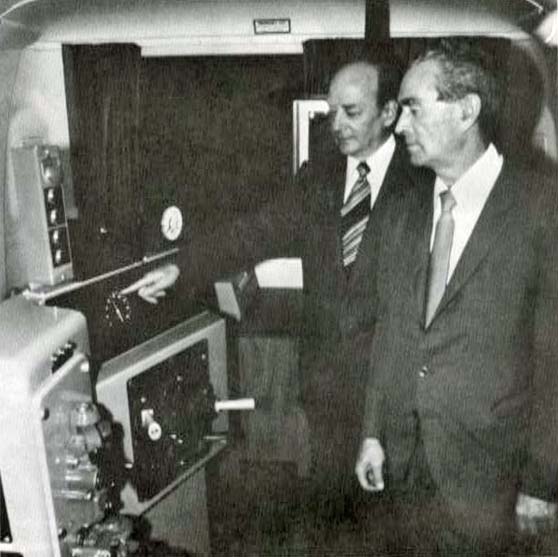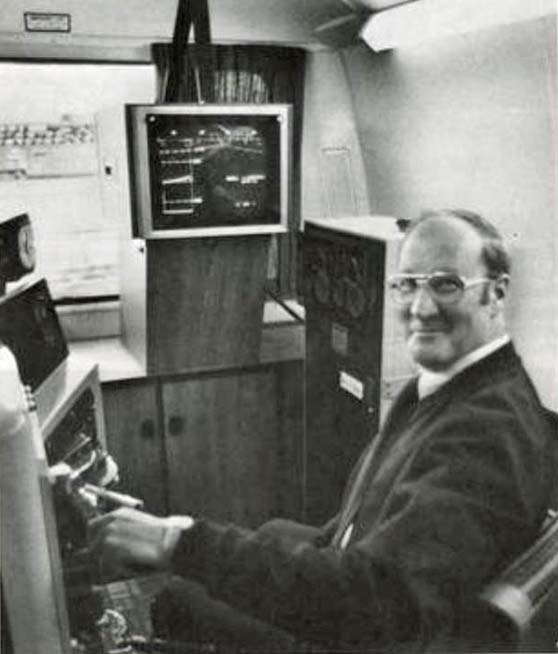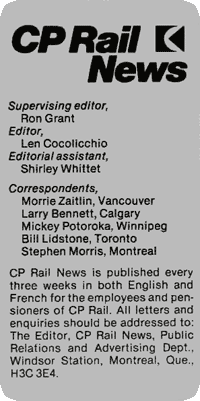
Number 15
Nov. 22, 1978
and Murray Chuckled
teaches old hoggers some new tricks

connection between the computer and the control mock-up in CP Rail's new train
dynamics simulator to Frank Smith, supervisor, Engineman Training, Eastern region.
By BILL LIDSTONE
Chapleau, Ontario - Engineman trainee Pat Connelly set his throttle on six as his train, all 35 cars and 5,700 tons of it, came past the mile 101 marker in the Nemegos subdivision, south of this Ontario town.
"You had better watch yourself going through the rock cut up ahead," advised his road foreman, Murray Hazen. "You've got 45 mile an hour track there, and if you take this train through there over 50, you've got real trouble."
Balancing his power against the weight of his train, Pat tries to hedge his speed, not wanting to sacrifice too much momentum, momentum he'll need a few miles farther on.
"You had better set your brakes, Pat," advised Murray, "let's see what will happen." The train starts losing acceleration as Pat touches the brake, activating the air brake system back down the train. He knows it will take a minute or two for the full effect of his braking to be felt.
Suddenly he realizes, too late, what is going to happen. Magnified by the composition of the train, between full and empty cars, the braking effect works down through the train, building on itself until the buff force exceeds 250,000 pounds and throws the train off the track like so many kiddies' toys.
"You've got them lined up sidewise for sure now, Pat," chuckles Murray, his hands vividly miming 30 jacknifed cars.
Chuckles?
Yes, chuckles, while the other four men, witnesses to this major derailment, sit back and chuckle too. Pat's train beeps at him and keeps going.
CP Rail's newest teaching tool, a train dynamics simulator, has just finished its first day, showing Pat Connelly and other enginemen in Chapleau ways of being better and safer at their jobs.
Some of the simulator's equipment may be familiar to many enginemen in CP Rail. To the left is a standard, SD40-2 control stand, to the front a television monitor. On the right is the two-tape mini-computer, the heart of the system. Still on the right but behind the engineman is a telex keyboard used for programming train type and make-up for the analyser, and a command consol where the operator controls the display.
CLASSROOM ON WHEELS
All this equipment used to make its home in Montreal's Windsor Station in the office of Dow Alexander, manager, Track/Train Dynamics. The situation is reversed now, though, as on its first trip Mr. Alexander is piloting the analyser's new home; a 32-foot GMC TransMode classroom on wheels.
And that's what is new, and most beneficial, about the train dynamics analyzer. It's mobile experience-on-wheels that can and will reach enginemen throughout the Eastern and Atlantic regions in the coming months. Both Dow Alexander and Frank Smith, supervisor, Engineman Training Eastern region, travelled with the machine on its first trip from Toronto to Chapleau and both have words of praise for the concept.
"The TransMode vehicle itself," says Mr. Smith, "is perfect for the job with seating for 10 and a rear air bag suspension that cradles the delicate computer parts. The system can work at any of our enginemen home points."
The system's mini-computer is the heart of the new teaching concept with taped programs simulating track conditions anywhere in the rail system, according to Dow Alexander.
"Five years ago the railways in North America began paying a great deal of attention to the phenomenon known as train and track dynamics, the play of forces through a train and how car placement and handling affect a train's stability. Our own study at CP Rail brought to light a great deal on this subject.
"From this work," continued Mr. Alexander, "we have been able to program the train and track profiles recorded in the computer. When an engineman or trainee sits down at the control stand in our mobile classroom, he can visualize both the landscape, track conditions, mileage points, and the problems coming up."

readies the brake switch while the TV monitor (background) displays a train simulation.
The mobile train dynamics simulator he's operating recently made its debut in this town.
TV MONITOR
The TV monitor facing the operator is divided into sections. Across the top of the screen is shown a white line on green background simulation of the track being used in a test marked off in miles and showing both grade variations and curves. On the left upper screen is simulation of the train type (looking like a line drawing of boxes) being used.
Tonnage and number of cars and whether they are empty or loaded appears on screen before the start of a simulation. To the right and center of the screen the computer shows the acceleration being applied in terms of miles-per-hour per minute gained or lost.
Beneath the upper left hand corner train simulation are the two electronic graphs that show the drag force (pulling force of the engine on the train) and the buff force (the force generated by the rear of the train pushing on the engines). Below this graph is the brake power display which portrays the effects of brake applications on the train.
 Balancing these
forces and the power needs of a train are the signs of good railroading.
Balancing these
forces and the power needs of a train are the signs of good railroading.
It's not only trainees that benefit from the analyzer. Engineman Keith Scott, with 31 years experience at the throttle, put it this way, "I've always thought you should never let a train run ragged, with too much slack, and this machine has shown me why. I've also tried a couple of different manoeuvers here at the trickier sections of track on my run that have shown me some new ways I can handle my trains."
Although there are no statistics ready yet, this kind of learning and experience is paying off. "Since we've started passing on what we now know about track and train dynamics," explains Mr. Alexander, "there has been a sizeable reduction in the number of "unknown cause" derailments as well as a lowering of major accidents to minor accidents.
"Now we'll be able to spread this training across the whole system. Between the new TransMode vehicle and the earlier mobile system that's now operating in the Prairie region, we should be able to reach all our enginemen and trainees."

